Published on November 11th, 2022
Last updated on February 3rd, 2023
How To Drain Dishwasher Water?
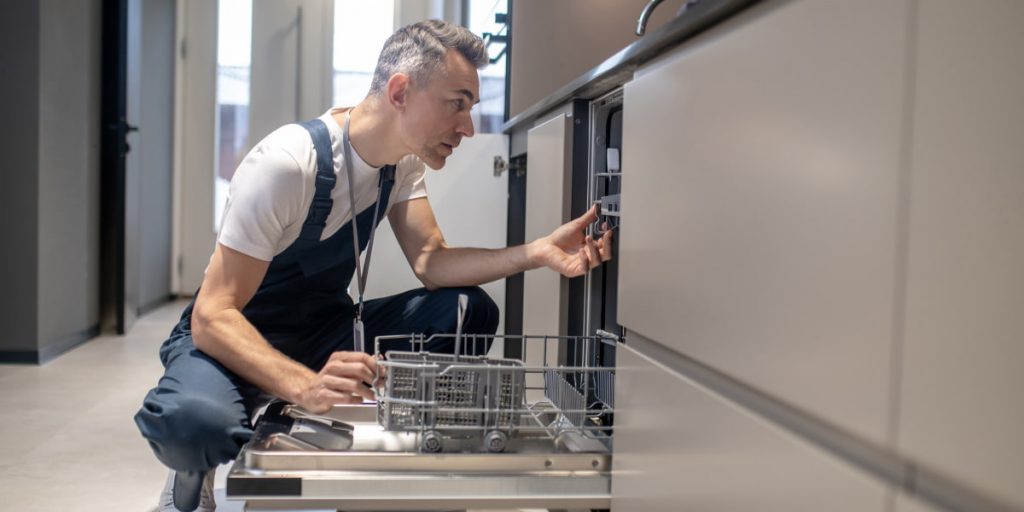
A dishwasher is a magical thing that does all the dirty work for you. But sometimes, such a mechanism can have specific difficulties, one of which is water in the bottom of the dishwasher. If you find it, do not rush to panic because you don’t necessarily have to ask for a specialist’s help with such a problem. In most cases, you can eliminate it on your own, and for this, you need:
- First, unplug the dishwasher from the electrical outlet and turn off the water supply;
- Soak the water in the bottom of the dishwasher;
- Disconnect the hose from the water supply;
- Remove the drain hose from the drain hole;
- Angle both dishwasher hoses so that water flows out of them.
If you notice that water remains in the bottom of the dishwasher after the wash cycle, you should also pay attention to the filters. They are the first cause of water stagnation in the dishwasher because all large impurities accumulate there. Therefore, clean the filters and check them for proper operation. If the water still does not drain, look for other reasons why it does not work.
4 Signs Your Dishwasher is Clogged
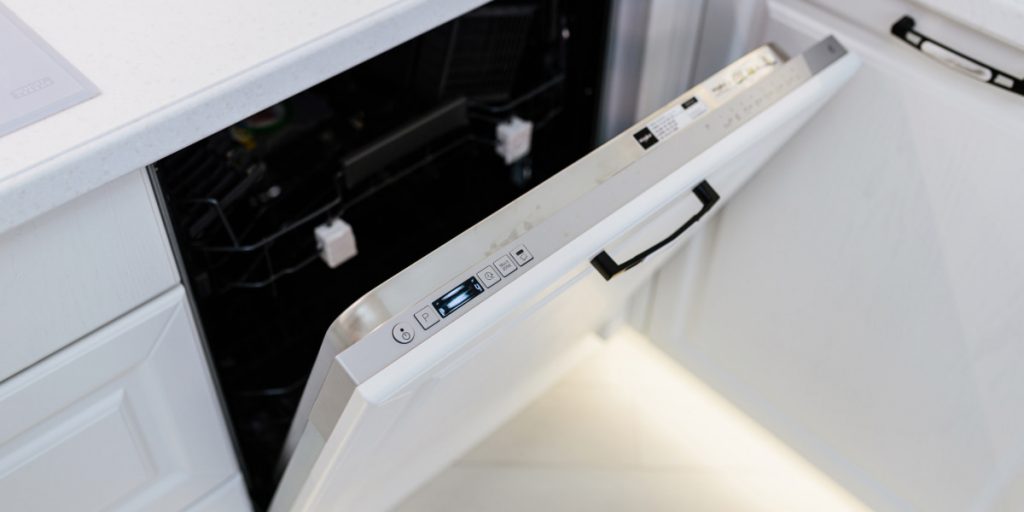
If your engine does not drain water, you need to urgently understand the problem’s causes. It can be either a clogging of the drain filter or a breakdown of one of the machine’s components, for example, a pump, drain sensor, or control board. Without knowing the cause of the malfunction, you can not return your dishwasher to working condition. Therefore, familiarize yourself with the reasons for a clogged dishwasher:
- Bending of the dishwasher drain hose
The water has nowhere to go if the hose connecting the machine to the sewer is bent or pinched. In this case, you need to straighten it carefully, turn on the power of an engine and try to start the drain mode again.
- Clogged the dishwasher filter
Do you know why this happens? Because most people neglect the rule of rinsing dirty dishes from food residues before loading them into the machine. It is the biggest reason for stuck water in the bottom of the dishwasher, which is due to the food remaining. But you can eliminate such a problem if you remove all the garbage from the filters.
- The suction of the dishwasher drain system
All contamination can pass through the filters and form blockages in the drain hose or at the point of its connection to the sewer. But you can handle even such a problem. So, prepare a container for draining water, carefully disconnect the drain hose from the sewer, lower it into the container and turn on the drain mode. Then, check whether your water runs off.
- Clogged the dishwasher drain pump
It is also a common reason why the dishwasher drain is clogged. But you can eliminate this if the machine’s construction allows you to reach the pump. To do this, it is necessary to carefully remove the pump, remove the blockage, and install it back. This way, you can clean it yourself.
So, if you find your dishwasher clogged and can not drain the water, first deal with the problem that caused it. And after it, you can proceed with the complete repair of the engine.
How to Drain Water in the Bottom of the Dishwasher?
When the dishwasher works, it is constantly in contact with water. Even when it is out of power, there is water in the machine’s system. However, it can sometimes cause you a lot of trouble. When water does not drain from the engine, this is the first indicator that it has certain malfunctions. And if this is not resolved, your dishwasher will not drain. Therefore, to avoid expensive repair of it by specialists, follow the next steps to solve this problem:
1. Turn off the Power to the System and Remove the Dishes
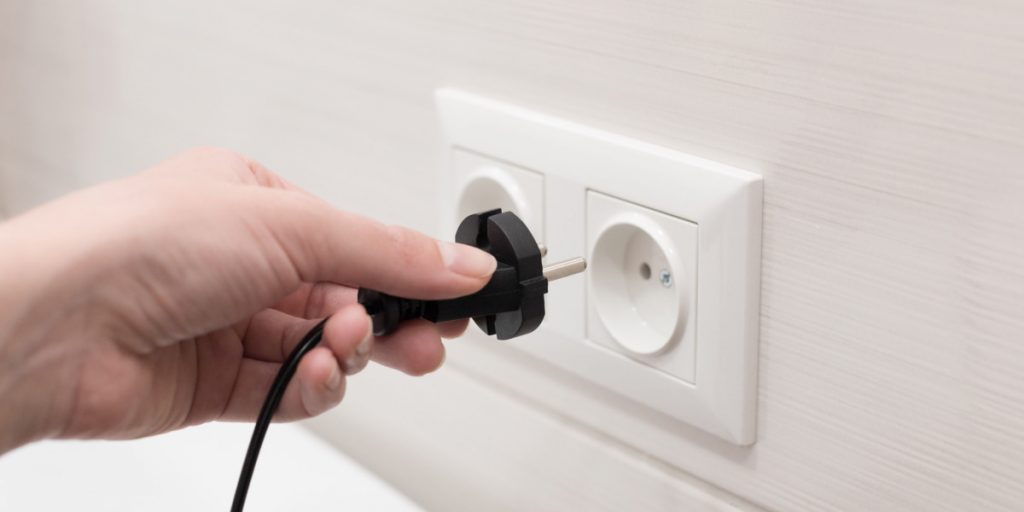
Disrupt the dishwasher from the power supply if you do not want an electric shock. Without this, it is forbidden to proceed with further clarification of the problem. So, do the next:
- Disconnect it from the outlet rather than just turning off the button.
- Then, you need to remove all the dishes from the dishwasher and the rack so that it is easier for you to continue working.
It will give you full access to all parts of the machine, and you will have more space to remove stagnant water.
2. Clean the Dishwasher
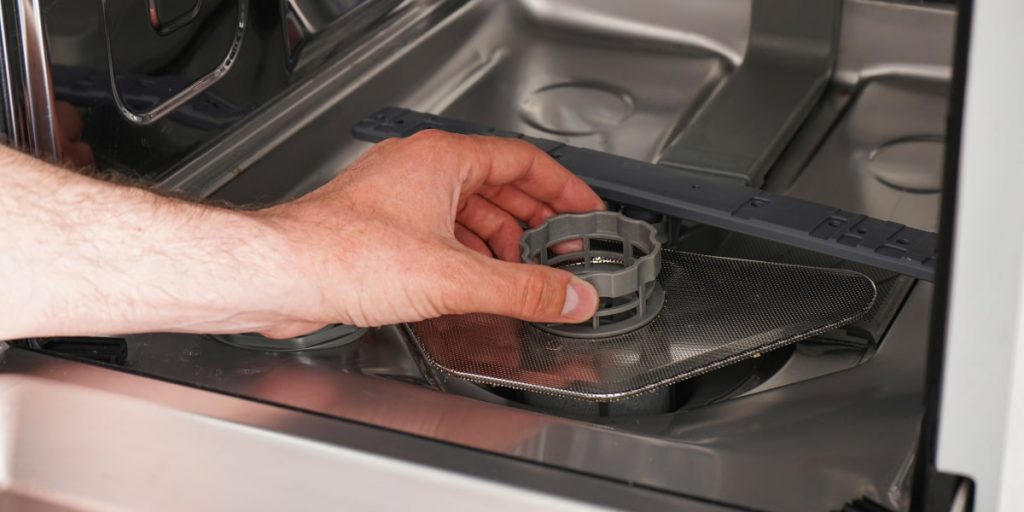
It is more pleasant to work with things that are clean, right? So, before removing water from the dishwasher’s bottom, you must clean the dishwasher of all food residues. The procedure can be a little unpleasant, but this way, you can quickly figure out the malfunction and avoid repeated contamination from this garbage.
3. Blot the Standing Water With a Towel
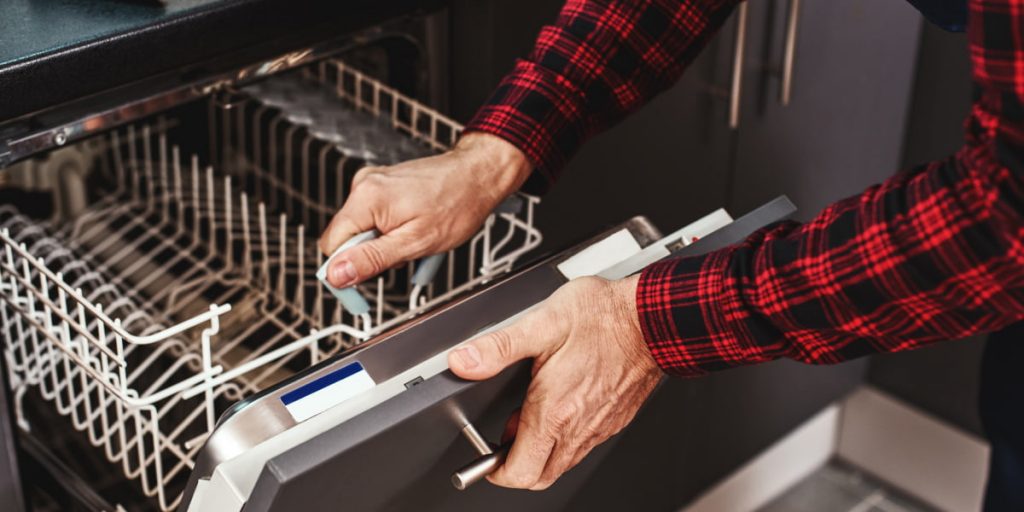
For this step, you must first lay out the towels in front of the dishwasher so the water that will be soaked up from the inside doesn’t get on the floor and under furniture. So, after that:
- Remove the lower basket. Depending on the amount of water, scoop up the container or wipe it with a sponge.
- Do this until there is almost no water left.
You can soak the water that leaves deep in the bottom of the dishwasher with a towel.
Now, when there is no water, and everything is dry, you can proceed to the next stage.
4. Clean the Filters

The filter is this thing that can accumulate all the food in a dishwasher, and as a result, it is clogged. If you don’t know what a filter looks like, it’s a thing that is similar to glass. To find it, you need to remove all the baskets in the dishwasher, under which you will see a filter at the bottom. It is necessary to twist it clockwise or pull it out of the socket (it depends on the machine’s construction) to get out. So, once you’ve got the filter out, do the following:
- Apply detergent to the filter and brush it. But remember that the brush should not be stiff, and it should be used very carefully.
- If the filter is dirty and greasy, you can add soda, which actively fights bacteria;
- Then clean the place where the filter should be placed.
- When everything is clean, put the filter in place.
Cleaning the filter is easy and does not require effort, but if you notice damage while washing it, you need to replace it with a new one immediately. It will save you from further severe damage.
5. Unclog the Drain
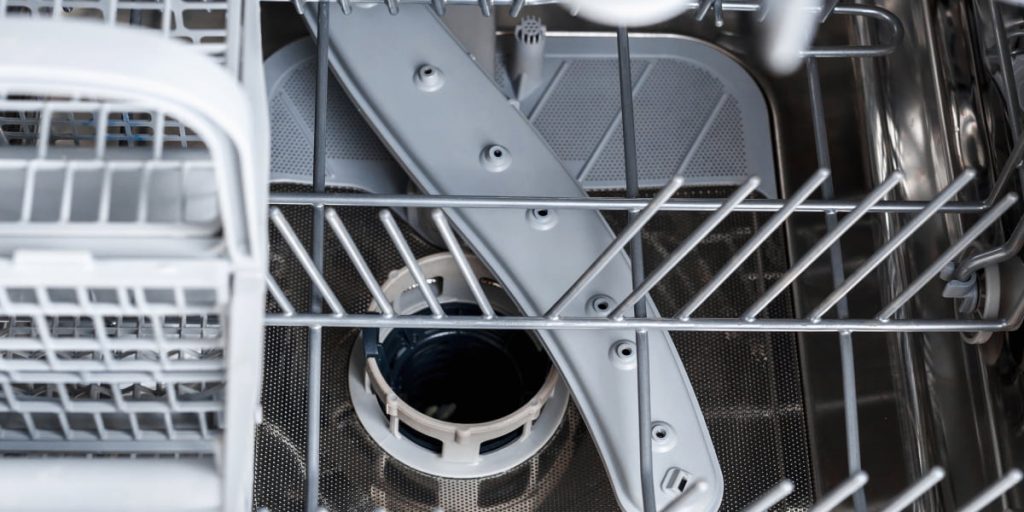
If you have ever cleaned a sink drain, then this step will be easy. The drain in the dishwasher is a hole under the filter that regulates water drainage. It can also accumulate garbage, but bigger than in the filter, for example, large pieces of food or other waste. It can lead to the fact that the dishwasher drain is clogged. To avoid this, you can use baking soda and vinegar to clean it faster and better. This mixture is widely used in the kitchen to eliminate unpleasant odors, disinfect, and much more. So, you need:
- Open the drain cover.
- Pour the mixture down the drain and let it work for 15 minutes.
- When this time is up, heat the water and pour it into the drain.
- When the chemical reaction starts, check if everything has cleared. If not, repeat the procedure.
Every dishwasher has a drain regulating the water mechanism, so when it is clogged, the machine may fail altogether. Therefore, it is essential to do this procedure in time to avoid problems with draining water in the dishwasher.
6. Clean the Sprayer Arms
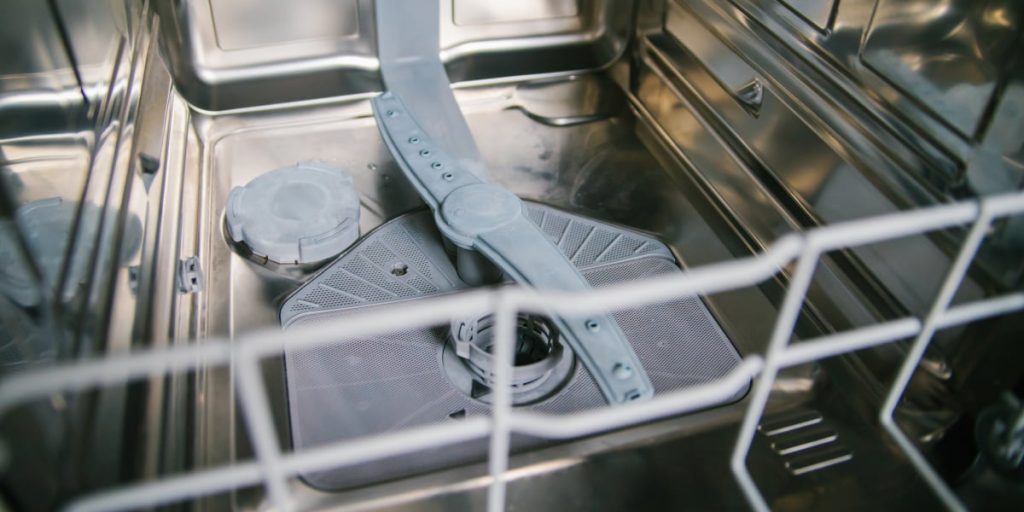
Your dishwasher will not drain if the spray arms are dirty. They can also collect dirt and food, so you need to:
- Remove the lower basket.
- Twist the lower sprayer arm and pull out.
- Pull out the upper basket.
- Twist the top spray and press it to remove it.
- Remove the upper basket.
- Twist the spray and push to remove it.
- Use a toothpick or other sharp objects to clean the holes.
- Rinse the spray arms with water and dry them with a clean cloth
- Screw the top and bottom parts into place.
After cleaning the spray arms, it is essential to ensure that there is no food left in it and that you have washed them well.
7. Check the Drain Hose
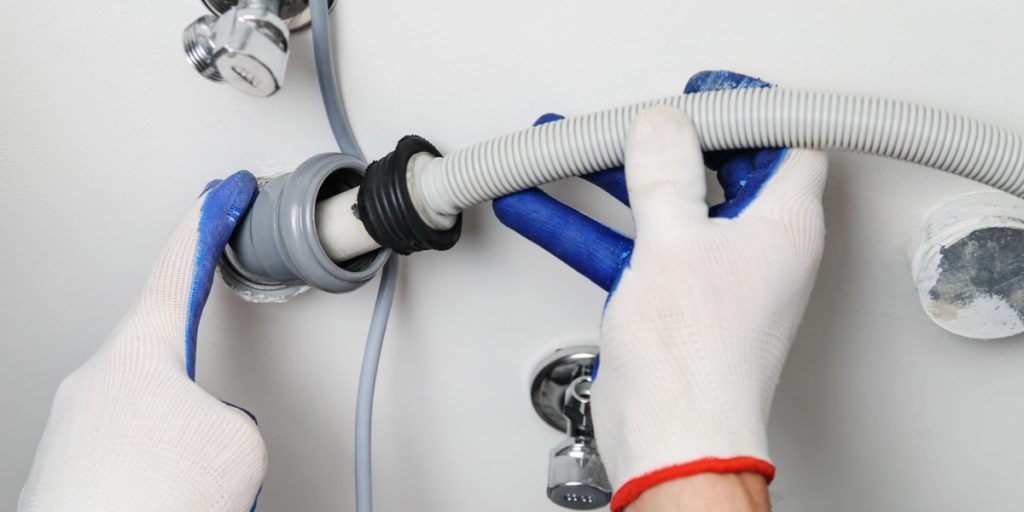
The drain hose can kink at any time. When it bends, all the waste can not pass through the hose, and the debris gets stuck. Accordingly, the water can not drain normally and remains in the bottom of the dishwasher. Cleaning such a hose can be tedious and take longer than usual, but the results are worth it. So, to clean the hose, you need:
- First, disconnect it and put a bucket under one of the ends so that you can collect all the food residues and soap there.
- Next, it is essential to pour a lot of water under pressure into the hose and collect dirt from the other side.
If the hose is badly damaged, you can easily replace it with another one, as they usually have standard sizes. If you do not do it in time, the dishwasher drain can be clogged.
8. Check the Water Pump
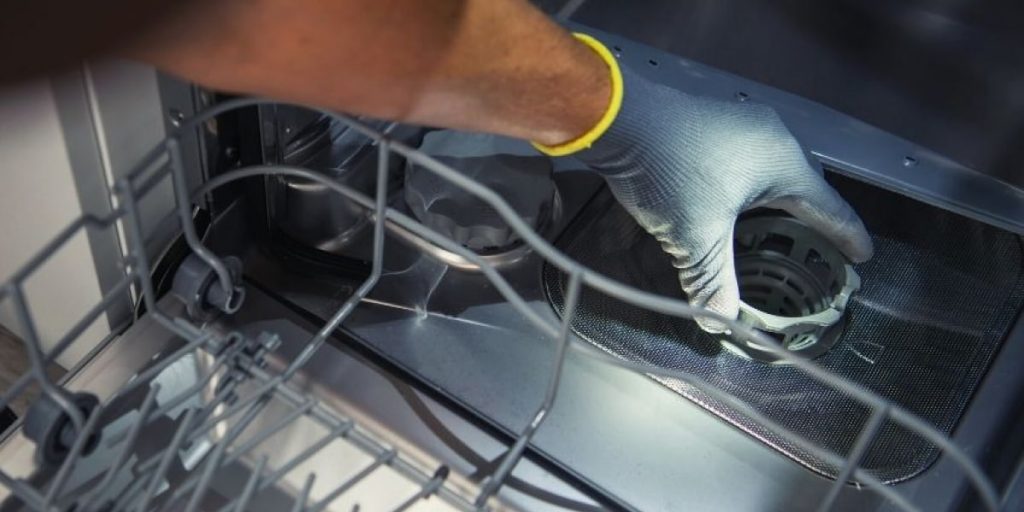
If the dishwasher continues not to drain, but the hose is fine, there is no other way besides checking whether the water pump is clogged. An obstruction in the pump can be detected by listening to the noise during the water cycle of the dishwasher. If no noise is detected, we advise you to check the pump propeller. The pump is usually under the filter, so:
- Start by removing it.
- After you have done this, you should consult the instructions for your dishwasher to know how to remove the propeller cover.
- When you remove it, you only have to check whether there are no residues that interfere with the regular operation of the screw.
- Next, after cleaning the propeller, cover the lid and check whether the dishwasher is working correctly with a short wash cycle.
If the problem is that the dishwasher is clogged precisely because of the water pump, then this stage should not be skipped.
9. Run the Dishwasher for a Short Cycle
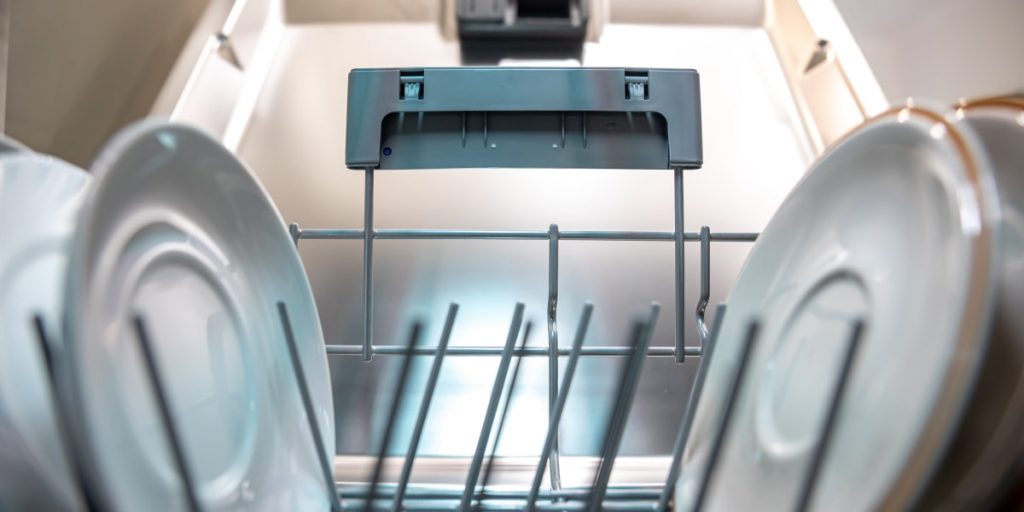
To complete the process of draining the dishwasher, do the following:
- Run a new wash cycle without any dishes inside the dishwasher.
- Pick the shortest cycle.
- After completion, check whether the water has drained and whether the mechanism functions normally.
If there is no more water in the machine, the operation has been successfully completed, and you can continue washing your dishes without any problems.
Summary
Water in the bottom of the dishwasher is a consequence of a careless attitude towards it or other technical problems. However, it can be solved, and it is not difficult at all. The most important thing is to find the leading cause of the malfunction and do everything clearly according to the instructions. This way, you don’t need to turn to specialists and do everything yourself.
FAQ
Is it safe to run a dishwasher with standing water in it?
No. If water has stagnated in your dishwasher and you turn it on, it can severely damage the mechanism. Water can get on the control unit or other essential parts. As a result, you will not be able to cope with such a problem independently and will have to turn to specialists.
How long should a dishwasher last?
According to manufacturers, dishwashers should last for about ten years. But in reality, due to technical breakdowns, such equipment works less. Usually, malfunctions appear after 5-6 years of using it. And if you do not take care of it, then after three years.
Do dishwashers drain when off?
No. A dishwasher can drain when it is turned on. As soon as the dishes finish the washing process, all the water automatically drains the dirty water through the drain hose. But if you want to remove the water when the dishwasher is off, you can do it with your own hands.
How do you clean a dishwasher drain hose without removing it?
You can clean the drain hose in the dishwasher using vinegar and baking soda. Mix this in equal proportions and pour it into the drain hole of the machine. Let it infuse a little, pour boiling water over it, and run the rinse cycle.


